Enjoy DatePsychology? Consider subscribing at Patreon to support the project.
The first article I wrote for this website was How Many Sexual Partners Did Men and Women Have in 2021. In this I analyzed sexual partner data from the General Social Survey. It is now 2023 and the GSS data from 2022 has been released. Here are some new numbers.
Nicholas Wolfinger at the Institute of Family Studies has already analyzed this data (Is the Sex Recession Over?). He found what looks to be 11-12% of men and women in 2022 who did not have sex for the 18-29 age range. Make sure to head over there and have a look.
My numbers are pretty close to this. A good sign, because I am sure Nicholas is a better statistician than I am. I used the PARTNERS variable and the recommended GSS weight in the R survey package for responses in 2022. In this I included the 18-35 age range and breakdowns by age. I also looked at sex within committed relationships and casual sex variables.
Number of sexual partners in 2022
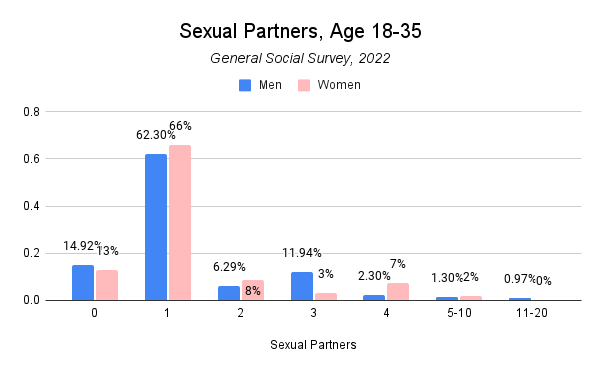
Here we see 13-15% of men and women reported having zero sexual partners in 2022. Most men and women reported having 1 sexual partner and the sex difference is pretty close. Most people did not have an excess of sexual partners.
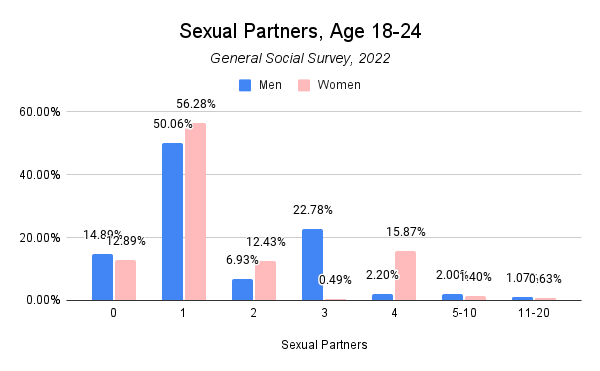
Here are sexual partners for the age 18-24 demographic. It doesn’t look like the youngest cohort is having less sex. This would be a reversal of the trend seen in previous years. Young men and women are also a little more likely to have had more partners. Perhaps what you would expect from the youth.
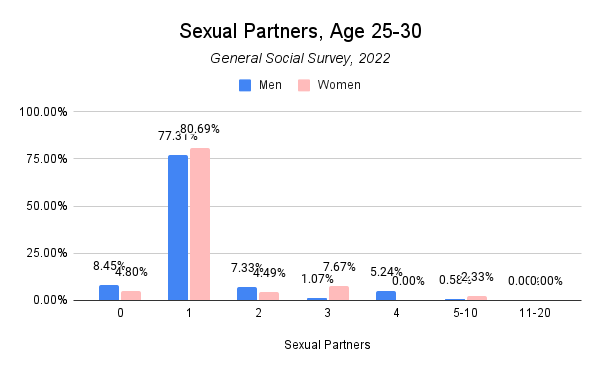
For the age 25-30 demographic, fewer men and women are without sex. This is consistent with the 2021 GSS data and trends elsewhere. By age 25, more people are “adulting” and are more likely to be in relationships. About twice as many men as women in this demographic reported being without sex, however. Promiscuity (more than 1-2 partners) was lower than for the youngest cohort.
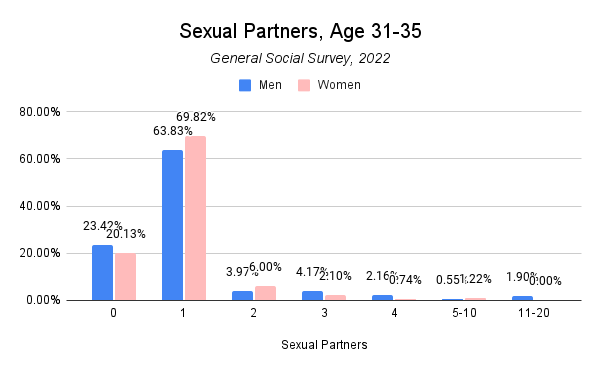
And for 31-35, a strange thing happens: we see a greater proportion of sexless men and women. Not much of a sex difference, but it is odd that the demographic most likely to be married or in committed relationships has such a high percentage of sexless individuals.
Sex in committed relationships
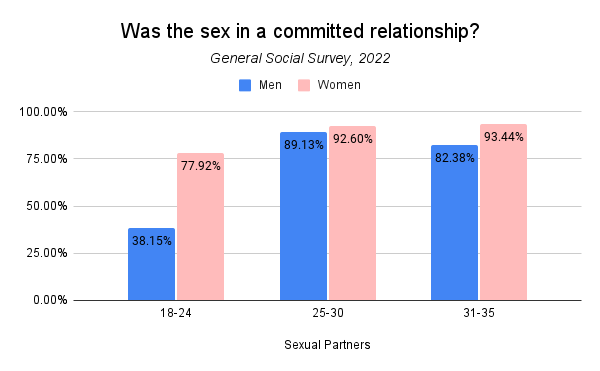
This chart shows the percentage of men and women who reported having sex in a committed relationship. The GSS variable used here is RELATSEX. For the older demographics, the sex difference is very close. This most likely reflects long term relationship formation.
What stands out is that for the youngest demographic of men are much less likely to report having had sex within a committed relationship.
Why might that be? Perhaps men and women view their relationship status differently. This may also be due to women dating up in age (outside of the 18-24 bracket).
Who are people having casual sex with?
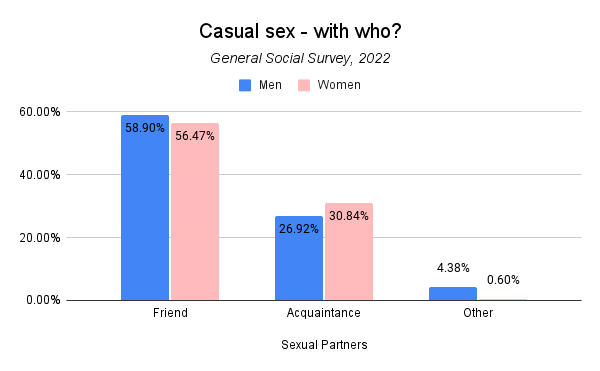
Who are the people having sex outside of committed relationships having it with? For most, it’s a friend or acquaintance. This uses the FRNDSEX, ACQNTSEX, and OTHERSEX variables.
Conclusions
What stands out? First, we don’t see a persistence of the trend of past years in increasing sexlessness in the GSS data. The distribution of sexual partners is similar, however, with most people being fairly restrained and reporting just one sexual partner. Most sex occurs in committed relationships, with the exception of men in the 18-24 age group, who were less likely to report that they had sex in a committed relationship. Most casual sex is sex with a friend, which could explain the sex difference here: men and women may view the “situationship” they are in differently.
7 comments
Would it be likely that the possibility of the numbers of sexless individuals at 30+ be accounted for primarily by dead bedroom scenarios, where one partner may have lost their libido or the couple just don’t engage in it any more (they got that out of their system when younger or changes since having children?) as opposed to just a rise in middle aged loneliness? The GSS data appears to not differentiate between those who were sexless and partnered in 2022 and those who are not partnered in the same time period.
It looks like most of the datapoints come from AImish or Mormon communities. Most of my West European female friends (from large and mid-size German cities) had all at the very least 10 bodies by the age of 21. Off course, this sort of Information would only be shared after a couple of drinks and in private. I cannot imagine US college educated women to be less slutty.
“It looks like most of the datapoints come from AImish or Mormon communities.”
The GSS is a nationally representative sample, i.e it is representative of all people living in the US, hence your claim that the “datapoints come from AImish or Mormon communities.” is blatantly false:
https://www.norc.org/research/library/2022-general-social-survey-data-released-to-public.html
“The GSS, a biennial, nationally representative survey, has been conducted by NORC since 1972 to monitor societal change and study the growing complexity of American society. ”
“Most of my West European female friends (from large and mid-size German cities) had all at the very least 10 bodies by the age of 21. ”
Your female friends are not representative of all women living in Western Europe, let alone Germany, so I would be very careful using this claim, given that it is very easy to invoke the hasty generalization fallacy. Besides, I would rather trust the stats on this topic rather than personal experiences(Look up “naïve realism”, “selective perception” and “anecdotal fallacy” for more info).
” I cannot imagine US college educated women to be less slutty.”
I remember seeing stats that show that college educated people are less likely to be slutty compared to non-college educated women. Maybe Alexander can help with this?
Im very skeptical of this data, so basically in just one minuscule year there was a 69% decrease in celibacy in women? Around a 460% plus increase in men with three reported partners. And women reporting 4 partners went from practically 0% in 2021 to around 16% in 2022. Yeah I dont buy it.
Im sory they either messed up the survey, or did it waaaay better than in previous years. They would’ve had to drastically changed the methodology for a result like this to appear.
Also im sure the GSS is struggling every year more and more wih people refusing to take their surveys. Not just them btw its happening with alot of surveys last time I checked, which was last year. I don’t know if that is still a thing though.
If you have read Wolfinger’s piece that actually went through the GSS data, you would notice that he mentioned the following:
“We shouldn’t declare the sex recession over based on just a single year of data—especially a single year that relied on new survey methods—and a fairly small sub-sample of 229 respondents. ”
https://ifstudies.org/blog/is-the-sex-recession-over
https://twitter.com/NickWolfinger/status/1661473504922079233
https://twitter.com/lymanstoneky/status/1661536213688254465
https://twitter.com/NickWolfinger/status/1661576889541230592?cxt=HHwWgIDUwZXYjY8uAAAA
https://twitter.com/NickWolfinger/status/1661465944970125312
Given that there was a small sub sample for 18-29 year olds, it is very likely that this is a blip and not a general trend. I also find it hard to believe that women reporting 4 partners went from practically 0% in 2021 to around 16% in 2022 and men reported a 460% plus increase for three reported partners.
“Also im sure the GSS is struggling every year more and more wih people refusing to take their surveys. Not just them btw its happening with alot of surveys last time I checked, which was last year. I don’t know if that is still a thing though.”
This maybe true, but I’m doubtful, given that last year’s GSS had a good response rate from all age demographics. I can visualize a small increase in number of partners this year due to relaxing covid restrictions and more opportunities to go out, but such a high increase is unbelievable.
Improve your data sources this is so sloppy but will trick a few good men
Get a better understanding of statistics and research methodology. Your black and white thinking will trick a lot of good men.